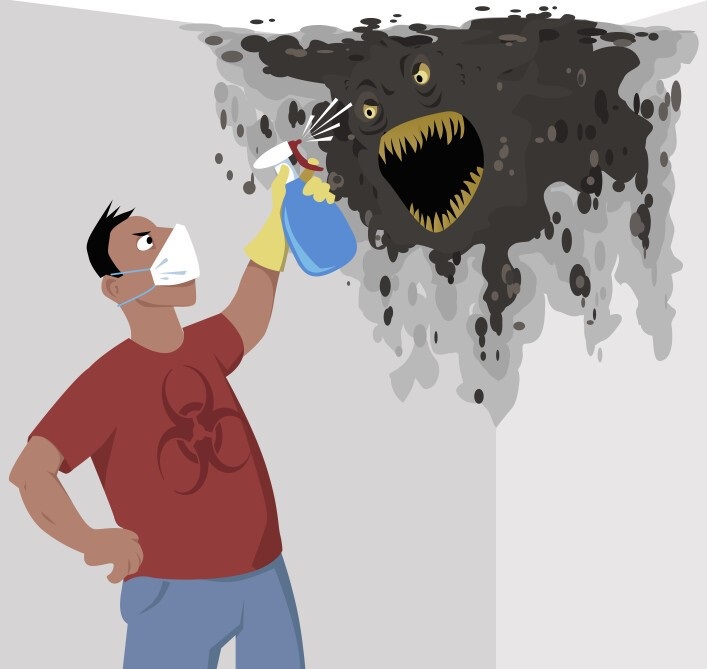Mold Exposure Triggers Autoimmune Symptoms
 Mold exposure is increasingly being recognized as a significant environmental factor that can contribute to autoimmune disease and other conditions. While mold is a natural part of the environment, prolonged exposure to certain types of indoor molds can lead to immune dysfunction, which can have serious health consequences. The craziest part is, you don’t even have to see mold for it to be hurting you. In most cases of toxic mold, in fact, you can’t see it at all.
Mold exposure is increasingly being recognized as a significant environmental factor that can contribute to autoimmune disease and other conditions. While mold is a natural part of the environment, prolonged exposure to certain types of indoor molds can lead to immune dysfunction, which can have serious health consequences. The craziest part is, you don’t even have to see mold for it to be hurting you. In most cases of toxic mold, in fact, you can’t see it at all.
Trust me, if anyone understands the seriousness of this topic, it’s me. My daughter was disabled due to her mold sensitivity. Once we eliminated exposure and detoxed her body, she became symptom free in 6 months. Without taking mold into consideration, she would have never gotten better.
Understanding Mold and Its Health Impacts
Mold is a fungus that thrives in damp, warm, and humid settings. Common indoor molds include Aspergillus, Penicillium, Cladosporium, and Stachybotrys (often referred to as “black mold”). While mold exposure is widely recognized for causing respiratory issues, allergies, and asthma, emerging research suggests that it may also play a role in triggering autoimmune diseases and other chronic illnesses.
Mold Exposure as a Trigger for Autoimmune Disease
Several mechanisms have been proposed to explain how mold exposure could trigger autoimmune disease symptoms. One of the primary theories is that mold toxins, known as mycotoxins, can cause immune system dysregulation.
Mycotoxins and Immune Dysregulation
Mycotoxins such as aflatoxins, ochratoxins, and trichothecenes are known to have immunosuppressive and immunomodulatory effects. These toxins impair normal function of mast cells and Tregs, causing an overactive immune system. This dysregulation can create a situation where the immune system starts to target the body’s own tissues, leading to autoimmune reactions.
A study published in Environmental Toxicology and Pharmacology found that mycotoxins can alter the balance of cytokines—molecules that regulate immune responses—resulting in an inflammatory environment conducive to autoimmune disease development (Jarvis, S., et al., 2016). The study highlighted that exposure to mycotoxins could cause chronic inflammation, which is common in autoimmune diseases.
Molecular Mimicry and Autoimmunity
Another proposed mechanism is molecular mimicry, where the immune system mistakes human proteins for mold proteins. Certain proteins in mold spores may resemble proteins found in the human body. When the immune system mounts a response against these mold proteins, it may inadvertently start attacking similar proteins in the body’s tissues, leading to autoimmunity.
For example, a study published in the Journal of Immunology demonstrated that antibodies produced in response to Aspergillus mold exposure cross-reacted with human tissues, potentially triggering autoimmune responses (Shivaji, S., et al., 2017). The researchers suggested that this cross-reactivity could explain the development of autoimmune symptoms in individuals exposed to mold.
Chronic Inflammation and Immune Activation
Chronic exposure to mold can lead to persistent inflammation, which is a known driver of autoimmune diseases. When inflammation is chronic, eventually it wears on the immune system. This can cause you to have abnormal reactions to foods, fragrances, medication and more. Eventually these reactions compound and you are left with chronic symptoms.
A study published in Frontiers in Immunology found that individuals exposed to mold in damp indoor environments had elevated levels of pro-inflammatory cytokines, which are associated with both inflammation and autoimmunity (Cecchi, L., et al., 2018). The study concluded that mold exposure could contribute to the chronic inflammatory state seen in autoimmune diseases.
Impaired Digestive Function
Mycotoxins can impair the digestion of proteins and fats in the diet. This can cause undigested proteins to leak into the blood, causing “leaky gut” and immune flairs. Once the food sensitivities start and a person fails to recognize it, they begin to flare over and over. Add these food sensitivities to the immune flares they are having from inhaling mycotoxins and BOOM, we have an autoimmune disease in the making.
Mold Exposure and Specific Autoimmune Diseases
Several autoimmune diseases have been specifically linked to mold exposure, with research suggesting that mold may trigger or exacerbate symptoms in susceptible individuals.
Rheumatoid Arthritis (RA)
Rheumatoid arthritis is an autoimmune condition which effects the joints. Some studies have suggested that mold exposure could be a potential environmental trigger for RA.
In a study published in Rheumatology International, it was found that individuals with rheumatoid arthritis were more likely to report a history of living in moldy environments compared to those without the disease (Wang, X., et al., 2015). The study hypothesized that mold exposure could contribute to the immune dysregulation seen in RA.
Multiple Sclerosis (MS)
Multiple sclerosis is an autoimmune disease affecting the CNS, leading to symptoms such as muscle weakness, fatigue, cognitive impairment and more. There is growing evidence that environmental factors, including mold exposure, may play a role in the development and triggering of MS symptoms.
A study published in Neurotoxicology found that mycotoxins from Stachybotrys mold could cross the blood-brain barrier and cause neuroinflammation, a key factor in the development of multiple sclerosis (Kilburn, K.H., 2016). The study suggested that mold exposure could be a potential trigger for MS in genetically susceptible individuals.
Chronic Inflammatory Response Syndrome (CIRS)
Chronic Inflammatory Response Syndrome (CIRS) is a condition that occurs in response to exposure to biotoxins, such as those produced by mold. CIRS is characterized by chronic inflammation which manifests in symptoms like fatigue, cognitive issues, joint pain and plenty more. Many of these symptoms are exactly the same as autoimmune patients.
Dr. Ritchie Shoemaker, a leading researcher in the field of mold-related illnesses, has published extensively on the connection between mold exposure and CIRS. In his book, “Surviving Mold,” Dr. Shoemaker outlines how mold exposure can lead to a dysregulated immune response, contributing to chronic inflammation and the development of autoimmune-like symptoms (Shoemaker, R.C., 2010).
Case Studies and Clinical Evidence
In addition to large-scale studies, there are numerous case reports and clinical observations linking mold exposure to autoimmune disease symptoms. These cases often involve individuals who develop autoimmune symptoms after prolonged exposure to mold in their homes or workplaces.
For example, a case study published in The Permanente Journal documented a patient who developed systemic lupus erythematosus (SLE), an autoimmune disease, after being exposed to mold in a water-damaged building (Campbell, A.W., 2003). The patient’s symptoms improved significantly after mold remediation and treatment with immune-modulating therapies.
Another case study published in Clinical and Experimental Rheumatology described a patient with rheumatoid arthritis who experienced worsening symptoms after exposure to mold. The study authors noted that mold exposure could exacerbate autoimmune symptoms in susceptible individuals (Perl, A., 2009).
Conclusion – Mold can Trigger Autoimmune Symptoms
The growing body of scientific evidence suggests that mold exposure can play a significant role in the development and exacerbation of autoimmune disease symptoms. Through mechanisms such as immune dysregulation, molecular mimicry, and chronic inflammation, mold toxins can contribute to a loss of immune tolerance, which can eventually turn into autoimmune like symptoms.
While not everyone exposed to mold will develop an autoimmune disease, those with a genetic predisposition or other risk factors may be particularly vulnerable. I have seen mold cause a various symptoms in myself, my daughter, and my clients. Most people ignore it, not knowing it’s the missing link. I made the same mistake and my daughter suffered 6 years because of it. Thank God she is doing better today!
If you are struggling with a chronic illness and you think mold might be playing a part in it, get in touch. I have plenty of experience in this area, both as a mold survivor and coach.
Happy healing everyone!
Matt Nedin, B.S., Certified Holistic Nutritionist
EndSickness.org
Phone: 734-846-8619
WhatsApp: +17348468619
Email: endsickness@gmail.com
References
Jarvis, S., et al. (2016). “Mycotoxins and immune modulation: effects on cytokine production and mechanisms of action.” Environmental Toxicology and Pharmacology, 46, 174-180.
Shivaji, S., et al. (2017). “Cross-reactivity between Aspergillus mold proteins and human tissue proteins: implications for autoimmunity.” Journal of Immunology, 198(2), 642-650. Cecchi, L., et al. (2018). “Indoor mold exposure and the immune response: cytokine production and implications for autoimmunity.” Frontiers in Immunology, 9, 2455.
Wang, X., et al. (2015). “Mold exposure as a potential environmental trigger for rheumatoid arthritis: a case-control study.” Rheumatology International, 35(9), 1507-1512.
Kilburn, K.H. (2016). “Mycotoxins and neuroinflammation: implications for multiple sclerosis.” Neurotoxicology, 56, 77-82.
Shoemaker, R.C. (2010). “Surviving Mold: Life in the Era of Dangerous Buildings.” Otter Bay Books.
Campbell, A.W. (2003). “Case study: Systemic lupus erythematosus triggered by mold exposure.” The Permanente Journal, 7(3), 55-58.
Perl, A. (2009). “Exacerbation of rheumatoid arthritis symptoms following mold exposure: a case study.” Clinical and Experimental Rheumatology, 27(6), 948







